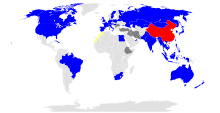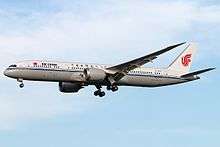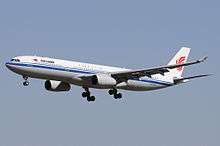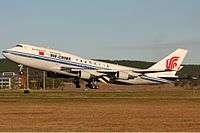Air China
 | |||||||
| |||||||
| Founded | 1988 | ||||||
|---|---|---|---|---|---|---|---|
| Commenced operations | 1 July 1988 | ||||||
| Hubs | |||||||
| Secondary hubs | |||||||
| Focus cities | |||||||
| Frequent-flyer program | PhoenixMiles | ||||||
| Alliance | Star Alliance | ||||||
| Subsidiaries |
| ||||||
| Fleet size | 405 | ||||||
| Destinations | 201 | ||||||
| Company slogan | Land Your Dream (Chinese: 伴梦想着陆)[1] | ||||||
| Parent company | Air China Group (53.46%) | ||||||
| Traded as | |||||||
| Headquarters |
Beijing Tianzhu Airport Industrial Zone Shunyi District, Beijing, China | ||||||
| Key people |
| ||||||
| Employees |
50,000 (April 2016) | ||||||
| Website |
www | ||||||
| Air China Limited | |||||||
| Simplified Chinese | 中国国际航空股份有限公司 | ||||||
|---|---|---|---|---|---|---|---|
| Traditional Chinese | 中國國際航空股份有限公司 | ||||||
| Literal meaning | China International Airlines, Company Limited by Shares | ||||||
| |||||||
| Alternative Chinese name | |||||||
| Simplified Chinese | 中国国际航空公司 | ||||||
| Traditional Chinese | 中國國際航空公司 | ||||||
| Literal meaning | China International Airlines Company | ||||||
| |||||||
| Air China | |||||||
| Simplified Chinese | 国航 | ||||||
| Traditional Chinese | 國航 | ||||||
| Literal meaning | National Airline | ||||||
| |||||||
Air China Limited is the flag carrier[2] and one of the major airlines of the People's Republic of China, with its headquarters in Shunyi District, Beijing. Air China's flight operations are based at Beijing Capital International Airport. In 2015, the airline carried 90 million domestic and international passengers with an average load factor of 80%.[3]
History
.jpg)
Air China was established and commenced operations on 1 July 1988 as a result of the Chinese government's decision in late 1987 to split the operating divisions of Civil Aviation Administration of China (CAAC Airlines) into six separate airlines: Air China, China Eastern, China Southern, China Northern, China Southwest, and China Northwest.[4] Air China was given chief responsibility for intercontinental flights and took over the CAAC's long haul aircraft (Boeing 747s, 767s, and 707s) and routes.
In January 2001, the former CAAC's ten airlines agreed on a merger plan,[5] according to which Air China was to acquire China Southwest Airlines. Before this acquisition, Air China was the country's fourth largest domestic airline. The merger created a group with assets of 56 billion Yuan (USD $8.63 billion), and a fleet of 118 aircraft.[6] In October 2002, Air China consolidated with the China National Aviation Holding and China Southwest Airlines.[7]
On 15 December 2004, Air China was successfully listed on the Hong Kong and London Stock Exchanges. In 2006, Air China signed an agreement to join the Star Alliance. It became a member of the alliance on 12 December 2007 alongside Shanghai Airlines.
In July 2009, Air China acquired $19.3 million of shares from its troubled subsidiary Air Macau, lifting its stake in the carrier from 51% to 80.9%.[8] One month later, Air China spent HK$6.3 billion (USD $813 million) to raise its stake in Cathay Pacific from 17.5% to 30%, expanding its presence in Hong Kong.[9]
In April 2010, Air China completed the increase of shareholdings in Shenzhen Airlines and became the controlling shareholder of Shenzhen Airlines, allowing Air China to further enhance its position in Beijing, Chengdu, and Shanghai as well as achieve a more balanced domestic network.[10]
On 2 December 2010, Air China received Spain's highest tourism industry award, the "Plaque for Tourist Merit." Air China was the first foreign airline to receive the award, which is given to organisations and individuals contributing to the Spanish tourism industry.[11]
On 23 December 2010, Air China became the first Chinese airline to offer combined tickets that include domestic flights and shuttle bus services to nearby cities. The first combined flight-shuttle bus ticket connected Tianjin via shuttle bus with domestic flights passing through Beijing.[12]
Air China began offering free Wi-Fi internet service on board its aircraft on 15 November 2011, making it the first Chinese carrier to offer this service.[13] However reported by users, the service is not allowed on smartphones, only tablets and laptops.
In 2012, after pressure from PETA, Air China stated that it would no longer transport monkeys to laboratories. PETA welcomed the airline’s announcement.[14]
On July 3, 2013 in time for the company's 25th anniversary, Air China successfully tested Wireless LAN in flight. It was the first global satellite Internet flight in Mainland China.[15]
In early 2015 it was announced that the airline had selected the Boeing 737 Next Generation and 737 MAX for its fleet renewal programme of 60 aircraft. The deal, with a value of over $6 billion at current list prices, has yet to be finalised.[16]
Corporate affairs
The entity Air China Limited was registered in 2003, and its shares began trading in Hong Kong and London on December 15, 2004. Originally the airline corporate entity was Air China International, which was founded 2002 Air China International incorporated China Southwest Airlines and the air transportation services of the China National Aviation Corporation, becoming a new entity.[17]
The Air China HQ Building (simplified Chinese: 国航总部大楼; traditional Chinese: 國航總部大樓; pinyin: Guó Háng Zǒngbù Dàlóu), the corporate headquarters, is located in Zone A of the Tianzhu Airport Industrial Zone (simplified Chinese: 天竺空港工业区; traditional Chinese: 天竺空港工業區; pinyin: Tiānzhú Kōng Gǎng Gōngyèqū) in Shunyi District, Beijing.[17][18][19] The company registered office is on the ninth floor of the Blue Sky Mansion (simplified Chinese: 蓝天大厦; traditional Chinese: 藍天大廈; pinyin: Lántiān Dàshà), also in Zone A of the Tianzhu Airport Industrial Zone.[20]
The enterprise logo of Air China consists of an artistic phoenix pattern, the name of the airline written in calligraphy by former national leader Deng Xiaoping, and "AIR CHINA" in English. The phoenix logo is also the artistic transfiguration of the word "VIP". Air China is a member of Star Alliance.
Air China is primarily based in its hub of Beijing Capital International Airport (IATA:PEK), where it operates numerous long range aircraft on routes to North America, Europe, South America, Africa and Australia. Its fleet is made up of an assortment of Boeing and Airbus aircraft, including: Boeing 737's, Boeing 777's, Boeing 747's, Boeing 787's along with Airbus A319's, Airbus A320's, Airbus A321's and Airbus A330's. Air China also operates a second hub in Chengdu International Airport, where it primarily flies domestic routes.
Destinations

Air China's route network extends throughout Asia to the Middle East, Western Europe, and North America from its hubs at Beijing Capital International Airport and Chengdu Shuangliu International Airport.[21] It also currently reaches a significant number of Asian, Australian and European destinations from Shanghai. Some international routes operate from Chengdu, Chongqing, Dalian, Hangzhou, Kunming and Xiamen. It is one of the few world airlines that fly to all six inhabitable continents.
On 10 December 2006, Air China began serving its first South American destination, São Paulo-Guarulhos (via Madrid-Barajas). This was the airline's longest direct flight. The service was initiated with a Boeing 767-300ER, but due to increased demand, the service has been upgraded to an Airbus A330-200.
Regular flights between Mainland China (PRC) and Taiwan (ROC) started in July 2009. Due to the political status of Taiwan, all Air China airframes that operate flights to and from Taiwan are required to cover the flag of the People's Republic of China on the fuselage, including a number of Airbus A320s, A330s, A340s, Boeing 777-200s, and Boeing 747-400BDSFs.
Air China introduced its new Airbus A330-300 to long-haul operations beginning with services to Düsseldorf, Germany in summer 2011. These aircraft provided the same two-class cabin standard as the Airbus A330-200 except that the economy cabin had no seat-back entertainment system installed (with the exception of the first two economy rows which also had increased legroom). Düsseldorf is now the third German destination on the Air China network. The airline launched a new Beijing-Milan-Malpensa service on 15 June 2011, complementing the airline's existing service to Milan from Shanghai.
Deliveries of the carrier's 19 new Boeing 777-300ERs commenced in mid-2011, with the aircraft forming the new "backbone of its future longhaul operations." The new Boeing 777-300ERs replaced the Boeing 747–400s on routes to U.S. destinations such as Los Angeles, New York, and San Francisco, but was expected to first enter service on flights to Paris from March 2012. The Boeing 777-300ER began to replace most 747 service once sufficient numbers entered the fleet.[22] Air China expanded its operations in India with a Beijing-Mumbai route begun in September 2011, while the existing Delhi route was upgraded to the A330.[23] The airline also launched service to Mumbai from Chengdu on 2 May 2012.[24] The airline began using the Boeing 777-300ER on one of its two daily Beijing-Los Angeles flights on 1 February 2012.[25] Beginning in late-2012 to early 2013, the airline will replace the Boeing 747-400s currently servicing the New York and San Francisco routes with the Boeing 777-300ER.[26] With the addition of the Boeing 777-300ERs on the US routes, Air China increased frequency on the Beijing-New York route, changing the flights from 7 to 11 flights a week by adding two new flights to the route (CA989/990).[27] On 21 January 2014, the airline launched its service to Hawaii with flights from Beijing to Honolulu, the first nonstop flights between the two cities.[28] The airline also increased the frequency of service on the Beijing-Houston Intercontinental route from four times weekly to daily service from 30 March 2014.[29] Beginning 10 June 2014, Air China introduced new nonstop service from Beijing to Washington-Dulles, operated by a Boeing 777-300ER.[30] As of September 29 2015, Air China also introduced a 3 times weekly flight to Montréal–Pierre Elliott Trudeau International Airport in a codeshare with Air Canada.[31] The Montreal flight was extended to Havana from 27 December 2015.
Air China started its direct flights to Johannesburg, South Africa from 29 October 2015.[32]
Codeshare agreements
Air China codeshares with the following airlines:[33]
- Air India
- Air Canada
- Air Dolomiti
- Air Macau
- Air New Zealand
- Air Serbia
- All Nippon Airways
- Asiana Airlines
- Austrian Airlines
- Avianca
- Cathay Dragon
- Cathay Pacific
- China Express Airlines
- El Al
- Ethiopian Airlines
- EVA Air
- Finnair
- Hawaiian Airlines
- Juneyao Airlines
- Kunming Airlines
- LATAM Brasil
- LATAM Chile
- LOT Polish Airlines
- Lufthansa
- Scandinavian Airlines
- Shandong Airlines
- Shenzhen Airlines
- SilkAir
- Singapore Airlines
- South African Airways
- Swiss International Air Lines
- TAP Air Portugal
- Tibet Airlines
- Turkish Airlines
- WestJet
- Uni Air
- United Airlines
- Virgin Atlantic
Fleet
Current
As of September 2018, the Air China fleet consists of the following aircraft:[34][35][36][37][38]
| Aircraft | In Service | Orders | Passengers | Notes | ||||
|---|---|---|---|---|---|---|---|---|
| F | B | E+ | E | Total | ||||
| Airbus A319-100 | 33 | — | 8 | — | — | 120 | 128 | |
| Airbus A320-200 | 44 | 13 | 8 | — | — | 150 | 158 | Deliveries from 2014[39] |
| Airbus A320neo | 5[40] | 28[41] | ||||||
| Airbus A321-200 | 61 | — | 12 | — | — | 173 | 185 | |
| 16 | 161 | 177 | ||||||
| Airbus A321neo | 1 | — | TBA | |||||
| Airbus A330-200 | 30 | — | — | 12 | — | 271 | 283 | |
| 30 | 207 | 237 | ||||||
| Airbus A330-300 | 29 | 6[42] | — | 36 | 20 | 255 | 311 | |
| 30 | 16 | 255 | 301 | |||||
| Airbus A350-900 | 3 | 7 | — | 32 | 24 | 256 | 312[43] | Deliveries started in August 2018. |
| Boeing 737-700 | 18 | — | 8 | — | — | 120 | 128 | |
| Boeing 737-800 | 110 | 60 | 8 | — | — | 159 | 167 | |
| 12 | 147 | 159 | ||||||
| Boeing 737 MAX 8 | 11[44] | 34[45] | 8 | — | — | 168 | 176 | Deliveries began in 2017 |
| Boeing 747-400 | 2 | — | 10 | 42 | — | 292 | 344 | |
| Boeing 747-8I | 7 | — | 12 | 54 | 66 | 233 | 365[46] | |
| Boeing 777-300ER | 28 | — | 8 | 42 | — | 261 | 311 | |
| — | 36 | 356 | 392[47] | |||||
| Boeing 787-9 | 14 | 1 | — | 30 | 34 | 229 | 293[48] | |
| Comac C919 | — | 20 | TBA | |||||
| Total | 397 | 169 | ||||||
Retired
| Aircraft | Introduced | Retired | Notes |
|---|---|---|---|
| Airbus A340-300 | 1997 | 2014 | One aircraft is currently stored |
| Boeing 707-300 | 1988 | 1993 | |
| Boeing 737-200 | 1988 | 1995 | |
| Boeing 737-600 | 2003 | 2009 | |
| Boeing 747-200F | 1990 | 2011 | |
| Boeing 747-200M | 1988 | 2000 | After retirement, all fleets were converted into freighters Transferred to Air China Cargo |
| Boeing 747-400 | 1993 | — | One aircraft was converted into Boeing Dreamlifter. |
| Boeing 747-400M | 1989 | 2013 | Two aircraft are currently stored Three fleets were converted into freighters and transferred to Air China Cargo |
| Boeing 747SP | 1988 | 2000 | |
| Boeing 757-200 | 2003 | 2014 | Most of the aircraft went to SF Airlines Four fleets were converted into freighter and transferred to Air China Cargo |
| Boeing 767-200ER | 1985 | 2009 | One crashed as Air China flight 129. |
| Boeing 767-300 | 1993 | 2012 | Two aircraft are currently stored |
| Boeing 767-300ER | 2003 | 2012 | |
| Boeing 777-200 | 1998 | 2018 | |
| British Aerospace 146 | 1987 | 2008 | |
| Hawker Siddeley Trident | 1974 | 1991 | |
| Xian Y-7 | 1987 | 1996 |
PhoenixMiles
PhoenixMiles (Chinese: 凤凰知音; pinyin: feng huang zhī yīn, literally "Phoenix Partner"), is the frequent flyer program of Air China and its subsidiary Shenzhen Airlines, Shandong Airlines, Tibet Airlines and Dalian Airlines. This is the first frequent flyer program launched in mainland China. It was designed to reward frequent flyers traveling internationally and domestically with Air China and its partner airlines.[49]
Air China Cargo
Air China Cargo, is a subsidiary of Air China, that focuses on freight delivery and does not transport passengers. It operates routes across Asia, Europe and North America with its fleet of Boeing 747-400F's, Boeing 757-200PCF and Boeing 777F.
Accidents and incidents
- On 16 December 1989, CAAC Flight 981 (operated by Air China), a Boeing 747-200BM (B-2448), was hijacked while flying the Beijing-Shanghai-San Francisco-New York City route. The hijacker's intended destination was Gimpo International Airport in Seoul, South Korea, but after South Korean authorities refused permission to land, the aircraft landed in Fukuoka Airport in Fukuoka, Japan. The hijacker was injured after being pushed out of the aircraft and was apprehended by Japanese authorities. The rest of the passengers and the crew were unharmed, and the aircraft returned to Beijing later that day.[50]
- On 10 August 1993, Air China Flight 973, a Boeing 767 was hijacked after takeoff from Beijing en route to Jakarta. A 30-year-old Chinese man passed a handwritten note to a flight attendant demanding to be flown to Taiwan. He threatened that his "accomplice" would destroy the aircraft unless he was flown to Taiwan. He was carrying a shampoo bottle containing a mixture of hydrochloric and nitric acids, and he threatened to disfigure nearby passengers with the acid unless his demands were followed. The aircraft was flown to Taipei International Airport, where the hijacker surrendered.[51]
- On 10 October 1998, Air China Flight 905, a Boeing 737-300 flying the Beijing-Kunming-Yangon route was hijacked by its pilot to Chiang Kai-shek International Airport in Taiwan. The pilot and his wife were apprehended by Taiwanese authorities. The passengers and the crew were unharmed, and the aircraft returned to mainland China later that day. This incident was the last hijacking to Taiwan of a mainland Chinese civilian aircraft.
- On 15 April 2002, Air China Flight 129, a Boeing 767-200ER from Beijing to Busan, South Korea, crashed into a hill while trying to land at Gimhae International Airport during inclement weather, killing 129 of the 166 people on board.[52][53] This is Air China's only fatal accident to date.
Controversy
Air China's inflight magazine Wings of China faced accusations of racism when they stated "London is generally a safe place to travel, however precautions are needed when entering areas mainly populated by Indians, Pakistanis and black people." in their September 2016 issue.[54]
On 8 September 2016, Air China issued an apology. Air China Media, which publishes the Wings of China magazine, said it wished to apologise to "readers and passengers who are feeling uncomfortable". It added: "This inappropriate description... was purely a work mistake by the editors and it's not the magazine's views...We will immediately recall this entire issue of magazines and draw lessons from this incident." [55]
See also
References
- ↑ "国航发布全新品牌形象:伴梦想着陆". Air China. Retrieved 2018-04-15.
- ↑ "About Air China". Star Alliance. Archived from the original on 18 October 2015. Retrieved 6 May 2015.
- ↑ Air China Annual Report 2015
- ↑ "Directory: World Airlines". Flight International. 2007-03-27. p. 55.
- ↑ Ng, Eric, "Air China Set to Announce Lead Bank for Listing," South China Morning Post, Bus. Sec., July 16, 2001, p. 4.
- ↑ Holland, Tom, "China Break-In," Far Eastern Economic Review, October 25, 2001, p. 41.
- ↑ "Air China plans to buy 15 new planes". Seattle Post-Intelligencer. Associated Press. October 30, 2002. Archived from the original on 6 February 2011. Retrieved 6 February 2011.
- ↑ Air China increases stake in Air Macau to almost 81%, Air Transport Intelligence news, 12.07.2010
- ↑ Air China to Raise Cathay Pacific Stake to 30% (Update2) Archived 2012-07-17 at WebCite, By Bloomberg News, August 17, 2009
- ↑ Air China acquires majority stake in Shenzhen Airlines, Air Transport Intelligence news, 22/03/10
- ↑ Air China Received Top Tourism Award TN Global Travel Industry News, Dec 3, 2010
- ↑ "air china launches flight shuttle bus combined ticket for domestic routes". Antara News. Retrieved 2015-02-23.
- ↑ "Broadband browsing at 32,000 feet: Air China introduces new fast internet service". Retrieved 8 September 2016.
- ↑ Wadman, Meredith. "Air China won't fly research primates". Nature. Retrieved 28 January 2015.
- ↑ 新闻中心, 中国经济网. "国内航班首试空中上网服务_中国经济网――国家经济门户". Archived from the original on 2016-06-29. Retrieved 8 September 2016.
- ↑ "Air China". Airliner World: 17. March 2015.
- 1 2 "Corporate Social Responsibility Report 2010." (Archive) Air China. p. 7. Retrieved on October 12, 2012. "Headquarter location No. 30, Tianzhu Road, Tianzhu Airport Industrial Zone, Beijing, China"
- ↑ "Membership." (Archive) IATA. Retrieved on October 12, 2012. "Air China Limited West 6th Floor Air China HQ Building No 30 Tianzhu Road Tianzhu Airport Economic Development Zone Beijing China (People's Republic of) 100621"
- ↑ "联系我们." (Archive) (Archive) Air China. Retrieved on October 12, 2012. "北京市顺义区天竺空港经济开发区天柱路30号国航总部大楼E410房间"
- ↑ "Interim Report 2012." (Archive) Air China. Retrieved on October 12, 2012. "The registered office of the Company is located at 9th Floor, Blue Sky Mansion, 28 Tianzhu Road, Zone A, Tianzhu Airport Industrial Zone, Shunyi District, Beijing 101312, the PRC."
- ↑ "Hainan Airlines set to establish Chengdu base". ch-aviation. 22 January 2017. Retrieved 23 January 2017.
- ↑ "Air China Expands With Second Daily Nonstop Flight From Los Angeles to Beijing". Prnewswire.com. Jan 12, 2011. Retrieved 2013-06-30.
- ↑ Business Standard (2011-07-01). "Air China expands India operations". Business-standard.com. Retrieved 2011-10-17.
- ↑
- ↑
- ↑ Christine Boynton (2012-01-19). "Air China begins replacing 747s with 777s on US routes". ATWOnline. Retrieved 2013-06-30.
- ↑ "New York to Beijing routes increased from one flight to two flights per day".
- ↑ "Air China commences new route". Archived from the original on 2014-02-19. Retrieved 2014-01-23.
- ↑ Houston Airport System (14 January 2014). "Air China Expands Nonstop Houston-Beijing Service To Daily". Retrieved 24 April 2015.
- ↑ "Air China to Commence Beijing-Washington Nonstop Service". wallstreet-online.de. Retrieved 24 April 2015.
- ↑ "Air China to Launch Beijing-Montreal Flights in Cooperation with Air Canada". newswire.ca. Retrieved 28 May 2015.
- ↑ "Air China puts direct route to SA on hold". News24. 29 May 2015.
- ↑ "Profile on Air China". CAPA. Centre for Aviation. Archived from the original on 2016-10-29. Retrieved 2016-10-29.
- ↑ "airfleets.net". airfleets.net. Retrieved 2017-02-11.
- ↑ 24 January 2017. "Air China Fleet in Planespotters.net". Planespotters.net. Retrieved 2017-01-24.
- ↑ Air China - Aircraft Information Airchina.com Retrieved 2016-11-23
- ↑ Air China Cargo Fleet ch-aviation.ch
- ↑ 24 January 2017. "Air China Cargo Fleet in Planespotters.net". planespotters.net. Retrieved 2017-01-24.
- ↑ 24 May 2013. "Air China Orders 100 Airbus A320 Jets". industryweek.com. Retrieved 2013-09-22.
- ↑ https://www.prnewswire.com/news-releases/air-china-takes-delivery-of-first-a320neo-powered-by-purepower-geared-turbofan-engine-300558442.html
- ↑ 27 May 2013. "Air China orders 100 Airbus A320 planes". cargonewsasia.com. Archived from the original on 2013-09-22. Retrieved 2013-09-22.
- ↑ "Air China in US$2.9b order for 12 Airbus A330-300 long-haul jets". channelnewsasia.com. Retrieved 2016-02-29.
- ↑ "Air China to take first A350 in early August". atwonline.com. Retrieved Jul 18, 2018.
- ↑ 30 June 2018. "Air China Fleet in Planespotters.net". Planespotters.net. Retrieved 2018-06-30.
- ↑ "Air China's current order".
- ↑ Used Primarily in Beijing to SFO and JFK serviceTemplate:Cite pweb
- ↑ "Air China begins 2-class 777 service from Dec 2016". routesonline.com. Retrieved 2016-10-01.
- ↑ 2016, UBM (UK) Ltd. "Air China Files Preliminary Boeing 787-9 Operational Routes in S16". Retrieved 8 September 2016.
- ↑ "PhoenixMiles". Retrieved 8 September 2016.
- ↑ Accident description for B-2448 at the Aviation Safety Network. Retrieved on 25 August 2014.
- ↑ "Hijacking description". Aviation Safety Network. Retrieved 29 August 2013.
- ↑ The Evil Queen (2002-04-15). "Chinese jet hits foggy mountain - World News". TVNZ. Retrieved 2013-06-30.
- ↑ "ASN Aircraft accident Boeing 767-2J6ER B-2552 Pusan-Kimhae Airport (PUS)". Aviation-safety.net. Retrieved 2013-06-30.
- ↑ "Air China Under Fire For 'Racist' Warning On London Minority Areas". Retrieved 8 September 2016.
- ↑ "Air China magazine apologises for London race slur - BBC News". Retrieved 8 September 2016.
External links
| Wikimedia Commons has media related to Air China. |
- Profiles
- Company profile Reuters
- Company profile Google Finance
- Company profile Yahoo! Finance
.jpg)

_Air_China_B-2037%2C_FRA_Frankfurt_(Rhein-Main)%2C_Germany_PP1374230291.jpg)
.jpg)

.jpg)
